Themed collection Host‒Guest chemistry: in honour of Luigi Nassimbeni’s 9th decade

Coordination polymers with embedded recognition sites: lessons from cyclotriveratrylene-type ligands
Coordination polymers with molecular recognition sites are assembled using cyclotriveratrylene ligands. Many show differential guest-spaces with host and lattice sites available, however common host–guest and self-inclusion motifs can block sites.

CrystEngComm, 2021,23, 4087-4102
https://doi.org/10.1039/D1CE00471A
Recent advances in probing host–guest interactions with solid state nuclear magnetic resonance
A recent update on how solid state NMR has aided the interpretation and understanding of host–guest interactions in the field of supramolecular assemblies is provided.

CrystEngComm, 2021,23, 2491-2503
https://doi.org/10.1039/D1CE00168J
Selectivity of hosts for guests by liquid-assisted grinding: differences between solution and mechanochemistry
Selectivity profiles obtained mechanochemically differ from those obtained in solution, both for selectivity during crystallisation and selectivity by guest exchange.
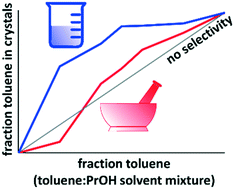
CrystEngComm, 2021,23, 7380-7384
https://doi.org/10.1039/D1CE01286J
Molecular recognition and solvatomorphism of a cyclic peptoid: formation of a stable 1D porous framework
Molecular aggregation and the hydrophobic effect explain the solvatomorphism and sorption behavior of a cyclic hexapeptoid.
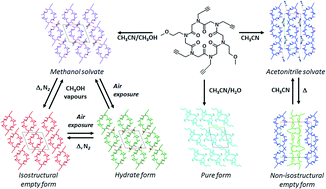
CrystEngComm, 2017,19, 4704-4708
https://doi.org/10.1039/C7CE01077J
A crab claw shaped molecular receptor for selective recognition of picric acid: supramolecular self-assembly mediated aggregation induced emission and color change
A crab claw shaped neutral molecular receptor selectively recognize picric acid.

CrystEngComm, 2017,19, 3557-3561
https://doi.org/10.1039/C7CE00642J
Steric influence on solvate formation – a comparison of resorcylic acid and two brominated derivatives
Unbalanced steric bulk can lead to increased solvate formation as shown in non-, mono- and dibrominated resorcylic acid.
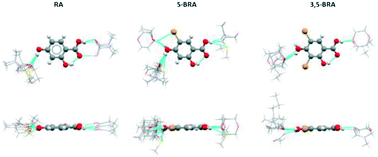
CrystEngComm, 2022,24, 1368-1376
https://doi.org/10.1039/D1CE01592C
A tryptophan-based copper(II) coordination polymer: catalytic activity towards Suzuki–Miyaura cross-coupling reactions
An unusual tryptophan coordination mode with copper(II) wherein L-tryp is coordinated through the carboxylate and amine groups. A heterogeneous catalyst for the Suzuki cross-coupling reaction with ∼98% yield under normal reaction conditions.
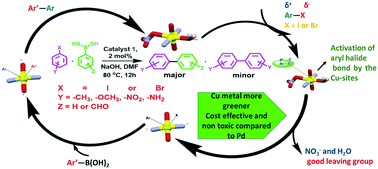
CrystEngComm, 2021,23, 7855-7864
https://doi.org/10.1039/D1CE01282G
Solvatomorph and polymorph screening of clopamide drug and its copper(II) complex crystals
The anhydrate and hemihydrate structures of the marketed drug, clopamide, are described the first time. Structural landscape of its copper complexes is presented: three polymorphic modifications and an isostructural series of its alcohol clathrates.
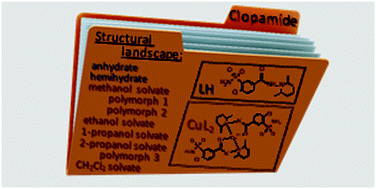
CrystEngComm, 2021,23, 7425-7441
https://doi.org/10.1039/D1CE00995H
Crystalline Cu(II) metal–organic frameworks based on a carboxamide pincer ligand and an NCONCON–Pd(II) pincer complex
Two copper MOFs based on carboxamide linkers are presented. This work shows how organometallic complexes with carboxylate functionalities can be repurposed to produce crystalline MOFs which can be used in carbon dioxide conversion.
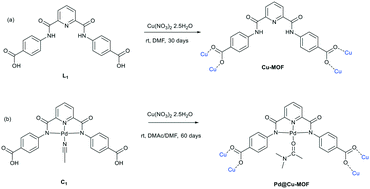
CrystEngComm, 2021,23, 7418-7424
https://doi.org/10.1039/D1CE00999K
Stabilization of liquid active guests via nanoconfinement into a flexible microporous metal–organic framework
The nanoconfinement of the three liquid guests within a MOF has been fully investigated in terms of host–guest interactions and framework rearrangement.
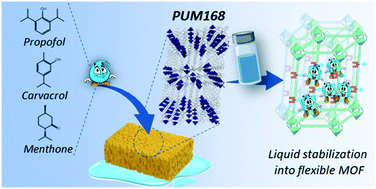
CrystEngComm, 2021,23, 7262-7269
https://doi.org/10.1039/D1CE00899D
Robust pyridylbenzoate metal–organic frameworks as sorbents for volatile solvents and gases
Double-walled pyridylbenzoate MOFs display an order/disorder phase transition on solvation/desolvation. This allows the MOFs to retain structural integrity over multiple sorption cycles.
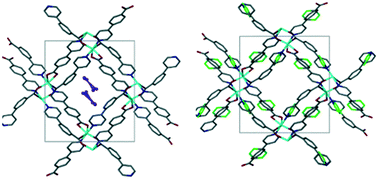
CrystEngComm, 2021,23, 7162-7170
https://doi.org/10.1039/D1CE01052B
Cyclodextrin complexes of the anticonvulsant agent valproic acid
Valproic acid (VAL) forms complexes with natural and derivatised cyclodextrins (CDs). Stoichiometries were deduced from NMR spectra, thermal and X-ray diffraction analyses, the latter revealing modes of VAL inclusion in CDs for the first time.
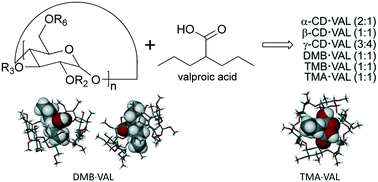
CrystEngComm, 2021,23, 6582-6590
https://doi.org/10.1039/D1CE01024G
Comparing the host behaviour of roof-shaped compounds trans-9,10-dihydro-9,10-ethanoanthracene-11,12-dicarboxylic acid and its dimethyl ester in the presence of mixtures of xylene and ethylbenzene guests
Each p-Xy guest molecule is surrounded by six dicarboxylic acid host molecules, forming a continuous intermolecular hydrogen-bonded motif through their carboxylic acid functionalities to form a cage-like structure in which the guests are trapped.
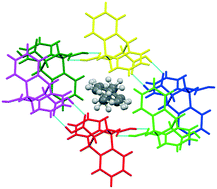
CrystEngComm, 2021,23, 4560-4572
https://doi.org/10.1039/D1CE00594D
Multicomponent crystals of baclofen with acids and bases—conformational flexibility and synthon versatility
Crystals of baclofen with acidic or basic coformers suggest that the robustness of the hydrogen bonding between the adjacent baclofen molecules aids the formation of the alternating hydrophilic and hydrophobic layers in the crystal structures.
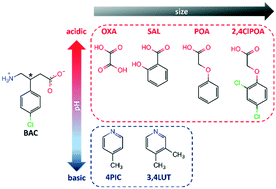
CrystEngComm, 2021,23, 91-99
https://doi.org/10.1039/D0CE01522A
Selective enclathration of xylenols: synergistic effects of mixed hosts
The six xylenol (XYL) isomers can be separated by selective enclathration with the host 4,4-isopropylidene bisphenol, H1. This selectivity is enhanced by the use of a second, complementary host in combination with H1.
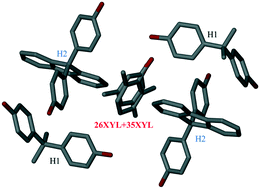
CrystEngComm, 2020,22, 7389-7398
https://doi.org/10.1039/D0CE00510J
A new dynamic framework with direct in situ visualisation of breathing under CO2 gas pressure
Structural evidence from in situ single-crystal X-ray diffraction analysis reveals flexibility in a new non-interpenetrated pillared-layer MOF that switches between a wide-pore and a narrow-pore form.
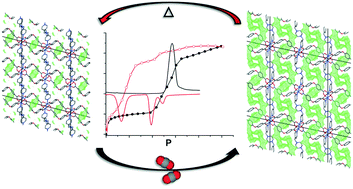
CrystEngComm, 2019,21, 3415-3419
https://doi.org/10.1039/C9CE00418A
Cyclic (H2O)6 confined hexameric host–guest assemblies and aerial CO2 fixation by electron-rich neutral urea/thiourea scaffolds
Neutral capsular assemblies of electron-rich tris-urea/thiourea receptors are formed via cyclic (H2O)6 trapping or atmospheric CO2 fixation.

CrystEngComm, 2018,20, 3741-3754
https://doi.org/10.1039/C8CE00611C
Crystallisation temperature control of stoichiometry and selectivity in host–guest compounds
A bulky diol host is only selective for tertiary butanol when versus 2-propanol at low temperatures.
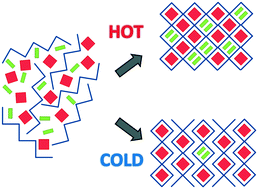
CrystEngComm, 2017,19, 5892-5896
https://doi.org/10.1039/C7CE01414G
Endo-/exo- and halogen-bonded complexes of conformationally rigid C-ethyl-2-bromoresorcinarene and aromatic N-oxides
Unlike that of the conformationally flexible C-ethyl-2-methylresorcinarene the structurally more rigid C4v cavity in C-ethyl-2-bromoresorcinarene prefers only small aromatic N-oxides stabilized through C–H⋯π interactions.
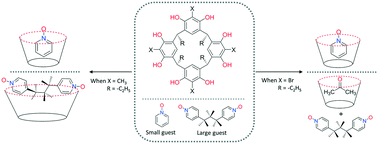
CrystEngComm, 2017,19, 4312-4320
https://doi.org/10.1039/C7CE00975E
Selectivity of aliphatic alcohols by host–guest chemistry
The selectivity of a bulky diol host compound displayed towards four alcohols with similar boiling points is matched by the thermal analysis results.
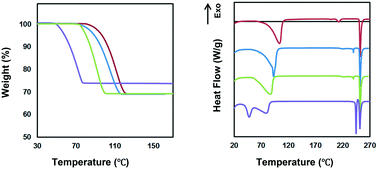
CrystEngComm, 2017,19, 3682-3688
https://doi.org/10.1039/C7CE00736A
About this collection
Host‒Guest chemistry: in honour of Luigi Nassimbeni’s 9th decade
Host‒guest chemistry has developed into a broad and exciting field of study, expanding rapidly from its early beginnings in the 1980s. From the study of inclusion compounds, this area of endeavour has evolved to encompass polymorphism, solid-state reactivity, multicomponent crystals, and mechanochemistry, with applications in separation, catalysis, chemical sensors and nanotechnology.
Luigi Nassimbeni has been highly influential in the development of this field, from early studies on hydrogen-bonded synthons, to advances in the separation of closely related organic compounds. Over the years, Luigi Nassimbeni mentored many students who have gone on to establish their own independent careers in the field. He played a significant role in development of solid-state chemistry in South Africa, particularly with regard to X-ray diffraction, and through his early application of thermal analysis to the study of inclusion compounds. He was ahead of his time when he proposed, during the 1980’s, that it might be possible to activate some molecular crystals to yield porous structures for guest inclusion. This collection highlights his recent publications in CrystEngComm, as well as other recent articles on the topic of host‒guest chemstry, along with new submissions from colleagues around the world.
In this themed collection we aim to pay tribute to the remarkarble achievements of Luigi Nassimbeni as he enters his 9th decade, and to celebrate him as an esteemed mentor, whose ideas and advancement of host‒guest chemistry live on in successive generations of supramolecular chemists.
This collection is guest edited by CrystEngComm Associate Editor Professor Susan Bourne alongside with Professor Len Barbour and Professor Nikoletta Bathori.